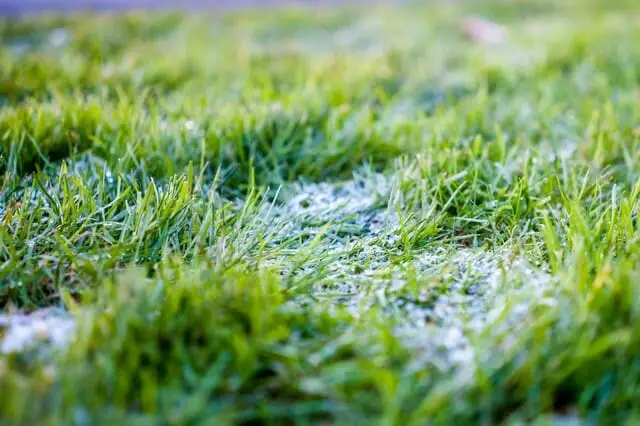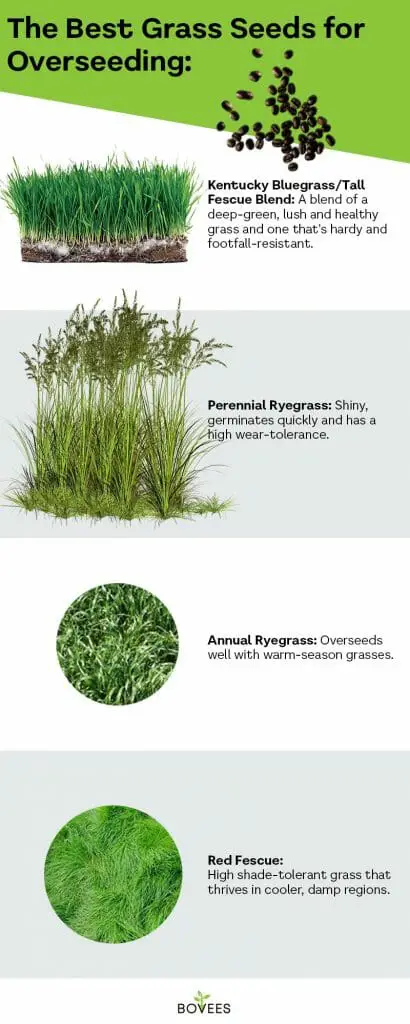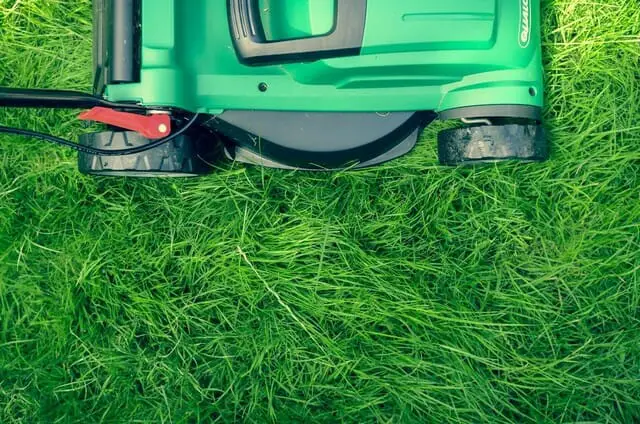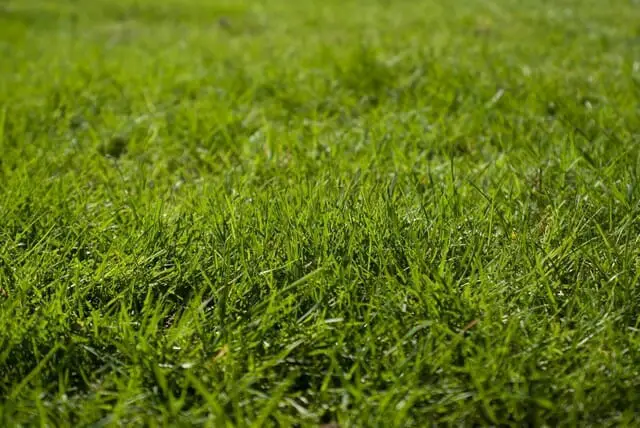Last Updated on April 14, 2022 by Grow with Bovees

Have you ever considered overseeding to keep your lawn looking great all year?
We know what you’re thinking; “overseeding” sounds like a negative thing to do, right? But, to overseed lawns has in fact shown to be useful if your lawn is in constant use or under constant stress, since it can prevent it from getting worn out and promotes a healthy lawn instead.
It is also an excellent way to maintain a lush and green, dense grass lawn vibe.
Before we look into overseeding in more detail, here is an overview of the best grass seed for overseeding your existing lawn right now:
- Kentucky bluegrass
- Tall fescue.
- Red fescue.
- Perennial ryegrass.
- Annual ryegrass.

The Benefits of Overseeding Your Lawn
Overseeding an already existing lawn with the right grass seed, maintains a lush, dark green color and healthy appearance of your turf.
Think about it: grass is a living entity and needs constant nourishment to survive, and walking over it constantly can take its toll after a while. This naturally slows the growth rate and eventually leads to thinning of your lawn.
Considering grass blades have a short lifespan of around 40 days only, you need your grass seed to regrow faster than it declines for it to stay healthy and strong. But, grass can’t always sustain this balance on its own.
Enter overseeding to ensure the positive regrowth rate, to achieve a healthier lawn in no time!
But before starting to overseed your already existing lawn with the right grass seed, there are a few things that need to be taken into consideration before starting this process. Namely: climate and sun exposure, coverage area and maintenance.
Climate & Sun Exposure
The specific climate and amount of sunlight that you are dealing with in the region that you wish to overseed lawns, is an important thing to consider when choosing the type of grass seed you want to use to overseed with.
Although most grass seed types will thrive and grow uninhibited in areas of full sun and or partial or light shade, it is not always the easiest choice.
Thankfully, however, seed manufacturers have come to make your life a bit easier in this regard as they are constantly working on making seed mixtures that are able to thrive in a specific climate.
For example, making seeds specifically for the rainy west or the warmer southeast as well as seeds that thrive in dense shade or harsh sun rays.
You, as a buyer, would be able to find specialized grass seeds that belong to the same varieties of grass, such as the fescue grass seed, for instance.
Coverage Area – How Much Seed To Overseed?
Another thing that needs attention is the amount of seed that you would need to overseed a certain area of lawn.
Here you would have to pay attention to whether or not the grass seeds are bare or coated, as well as, the general condition of the lawn that needs overseeding.
A good rule of thumb is to always follow the coverage recommendations that are found on the packaging of the grass seed purchased.
If you are making use of grass seed that is coated, you will need less amount of seeds for lawn coverage. This is simply because coated grass seeds are larger.
The rate at which you would spread a certain grass seed also varies depending on the type of seeds you are going to use.
As an example of a spread rate, one could use 5 to 10 pounds of seed for every 1000 feet of lawn. In this case, the average amount for overseeding a lawn would be 5 pounds for every 1000 feet of turf. This information you will also find on the package labeling.
As a rough guide, when using the best grass seed for overseeding, the rule of thumb is to use at least either half the normal seeding rate or half of the seed rate you’d apply on bare soil. So, if the normal seed rate is 6 pounds of seed per 1,000 square feet, go with 3 pounds of grass seed per 1,000 square feet.
Maintenance
Lawn care and maintenance as well as the proper attention is a general requirement of keeping any lawn beautiful and healthy.
There is no such thing as growing a maintenance-free turf. You can, however, reduce the amount of maintenance needed by choosing a type of grass seed that is suitable to grow in your region.
By reduction in maintenance I mean mowing the lawn less as well as less frequent waterings and applications of fertilizer.
If you want to avoid constant mowing of your lawn, choose a grass variety that is low-growing rather than one that is tall-growing. One example here would be fine fescue.
If on the other hand you feel like watering your grass is a tedious task, choose a grass seed type that is drought resistant or tolerant.
One example of a low-maintenance drought resistant grass type is Bermuda grass. This grass type is classified as a warm season grass and also happens to be considered as one of the best low-maintenance lawn for sunny climates and warm temperatures.
It is generally always best to choose a lawn seed type that is native to or suitable for the region that you live in. This way the maintenance of the lawn will automatically be less.
Soil Quality
The quality of your soil also plays an important role in keeping a healthy lawn. If your soil has the right amounts of nutrients, naturally your lawn will grow and thrive better.
Overseeding your lawn is a great way to improve your soil health. This process aids in soil fertility by adding essential organic matter to the base of your soil.
If you are not sure of the quality of your soil, simply test your soil. This you can do by purchasing a easy to use home soil test kit and you will know the contents of your soil in no time.
The Best Time to Overseed
You have two options as to when to overseed your lawn with new grass seeds:
- Regularly to prevent thinning; or
- As and when needed to treat specific worn lawn areas.
The best time to overseed your lawn depends on the grass type.
If you overseed in the spring, it’s great.
Many people, however, wait too long, resulting in their sowing taking place during the summer, when it is much more difficult for new grass to germinate.
If, on the other hand, you are in the practice of spraying a crabgrass preventative herbicide in the spring, you can skip the spring seeding.
The majority of pre-emergent herbicides can prevent all seed germination for up to 12 weeks, which puts you smack in the thick of the growing season.
As an alternative, it is better to overseed immediately following aeration of the grass, which should be done in the fall.
Cool-Season Grasses
Overseed Northern lawns, also known as cool-season grass species in late summer or early fall. The soil is still warm enough during early fall.
This is because of the hot summer heat; hence it provides a conducive environment for fast seed growth. There’s also adequate precipitation in fall to keep the soil moist, which is ideal for cool season grasses.
Examples of cool season grasses include tall fescue and Kentucky bluegrass.
Ideally, the temperature ranges should be:
- Soil temperatures: 50–650F.
- Air: 60–750F.
Warm-Season Grasses
If you have a warm-season grass variety, overseed in late spring. Usually, this is the time when warm-season grasses get into active growth.
Examples of warm season grasses include Bahia, St. Augustine and Zoysia, just to name a few.

What To Do Before Overseeding
You need to prepare the grass and soil first before figuring out how much grass seed is needed:
Step 1: Mow The Lawn
Mowing ensures the seed mixture doesn’t get caught on the blades:
- Cut the grass to 2 inches (5.08 cm) or lower to ensure the seeds reach the soil.
- Use a metal rake with strong tines to remove the cuttings and scratch the soil to loosen it.
- Get rid of stones, dead grass and other debris, too.
Step 2: Aerate The Soil
Aerate the lawn using a core aerator, plug aerator, lawn aerator shoes or a manual plug aerator. This will ensure a sufficient air supply to the soil, particularly if your yard is composed of clay soil. Clay soil is known to be dense and sticky, this is why proper aeration is of the essence in this type of soil.
Step 3: Feed Your Lawn
Ensure you apply some organic grass fertilizer if the lawn hasn’t had any fertilizer for the past four months.
However, wait 3 to 4 days before overseeding so that the starter fertilizer can take effect.
How to Overseed Your Lawn
There are a couple of popular methods of overseeding. You can consider slice seeding vs overseeding. You will get faster growth with slice seeding, than with regular overseeding.
Once you’ve prepared your lawn, simply use a broadcast spreader to spread the new grass seed evenly and fast. However, feel free to use a handheld spreader if you have a small yard.
Overseeding turf should be a gradual process of enriching your lawn. Using too much seed in an attempt to make your lawn thick, lush and healthy within three months will only lead to overcrowding. This isn’t healthy for growth because it leads to competition for limited essential nutrients.
What To Do After Overseeding
You’re not quite done!
Follow these tips for maximum effect:
- Water: After spreading the seeds on the lawn, keep the ground well-watered—2 to 3 times a day until the seeds germinate and the shoots sprout. Freshly planted grass seed enjoys moderately wet soil.
- Keep off the grass! Ensure there’s little to no traffic on the lawn for one to three weeks to give the seeds ample time to grow without any disturbance.
- Cover: Use a net or garden fleece until the new seeds sprout to prevent birds from eating the seeds. Covering grass seed is, however, most commonly limited to newly seeded lawns as opposed to overseeded lawns.
What Are the Best Grass Seeds To Use for Overseeding?
So now your brain is full of overseeding knowledge, it’s time to choose the best type of grass seed from these options:
Kentucky Bluegrass Seed
Kentucky bluegrass mix is one of the better grass seeds to overseed with as it’s a popular cool-temperature grass. It’s known for its dark green color and rich density.
The young grass spreads aggressively over the lawn, making it perfect for healing damaged patches of grass through overseeding.
It also survives well in high-traffic yards and under scorching sun rays. This makes it ideal for fairways, lawns and athletic fields. These traits also make it one of the best grass seeds for overseeding different lawns.
Unfortunately, bluegrass doesn’t do well in shaded lawns, so consider perennial ryegrass if your lawn is shaded. Other cool season grasses, that are not bluegrass, may also prefer areas of rather dense shade.
Pros
- Rich green color and dense texture.
- A good spreading grass seed choice.
- Available in both seeds and sods.
- High tolerance to cold climates.
Cons
- Not shade tolerant.
Tall Fescue Seed
This fescue variety is a perennial cool-season grass with a deep root system and wide, dark-green blades.
Its deep roots ensure that it grows upright and in clumps, forming a dense and lush lawn, making it one of the favorite grass seed types for reseeding your existing grass.
Using this grass seed for overseeding will maintain a beautiful green lawn and a dense appearance starting mid-spring into as late as early winter.
Perhaps its greatest attribute is thriving in different environments. It grows efficiently in both full sun and a light shade and in various soil types, like loamy, chalky and clay soils.
You can overseed it without issue, and you do not need to water this lawn regularly — except in summer — or fertilize it often. These benefits make it an excellent low-maintenance option and a best grass seed for overseeding contenders.
An excellent choice for overseeding tall fescue grass, is using the popular and highly trusted Scotts Turf Builder Sun and Shade Mix.
The downside of using this grass seed is its susceptibility to lawn diseases. In particular, a fungal disease called brown patch when grown in humid areas.
Pros
- Low-maintenance.
- High heat tolerance — drought resistant.
- Doesn’t wear easily.
- Thrives outside its adaptation zone.
Cons
- High water usage in the summer.
- Susceptible to brown patch disease.
Red Fescue Seed
This is a shade grass seed that thrives in cooler, damp regions, making it the best grass seed for fall overseeding.
With this in mind, combine this cool season variety with a warm-season grass variety in the fall for the best results. It’s a particularly good option if you live in the US’s transition zone, where it’s notoriously difficult to grow grass.
It’s also excellent for allowing fewer weeds and doesn’t require much mowing, despite having a fast seed germination rate.
Be aware that it doesn’t thrive so well when exposed to lots of sun but works better in the shade.
Pros
- High shade tolerance.
- Good for the transition zone.
- Combats weed growth.
- Fast germination rate.
Cons
- Can’t survive the full summer sun.
Perennial Ryegrass Seed
This seed stands out as one of the best grass seeds for overseeding existing lawns because of its shine, high tolerance to wear and partial shade and its ability to grow fast. Plus, you can mow it to a low height.
Overseed it on your lawn if you want an improved lush appearance and tolerance to different elements. The only problems you’ll have with perennial ryegrass are its high maintenance and the fact that it’s not dense enough to be a stand-alone grass.
Note: You can combine the benefits of tall fescue and perennial rye with the Pennington Smart Seed, which needs 4 to 8 hours of sun per day and is excellent for overseeing.
Pros
- Shiny, lush green grass for a beautiful lawn.
- High wear tolerance.
- Germinates fast.
- Can survive low mowing.
Cons
- High maintenance requirement.
- Not dense enough to grow on its own.
Annual Ryegrass Seed
Annual ryegrass is one of the best lawns to overseed with and a top choice for a green lawn all-year-round. It’s particularly popular with other warm-season options since it’s best used in cooler temperatures.
This grass variety is often used to prevent erosion or alternatively to add some eye-catching curb appeal when a house is being listed for example.
The annual variety holds one over the perennial rye type, since it lives longer, saving you a bit of your hard-earned cash. But, if your lawn is prone to diseases, perennials are more stubborn.
Pros
- Great for full-year green grass.
- Combines well with warm-season grasses.
- Long lifespan.
Cons
- Less resistant to disease than perennial ryegrass.
- Poor quality turf grass as a stand-alone.

Overseeding Is Good for Lawn Survival
There you have it, a brief explanation of the best grass seed for overseeding your lawn.
You have the choice of using different warm and cool-season grasses, so make sure the new grass seed mixture suits your location.
For instance, Kentucky bluegrass is the best grass seed for overseeding lawns if you want to maintain a healthy, lush look and heal damaged parts of the lawn and enhance its tolerance to cold weather.
For low-maintenance lawns that don’t need much fertilization, tall fescue is the best grass seed for overseeding.
In contrast, perennial ryegrass seed germinates faster and has a high heat tolerance, so consider this as the best grass seed for overseeding in areas of warmer climates.

